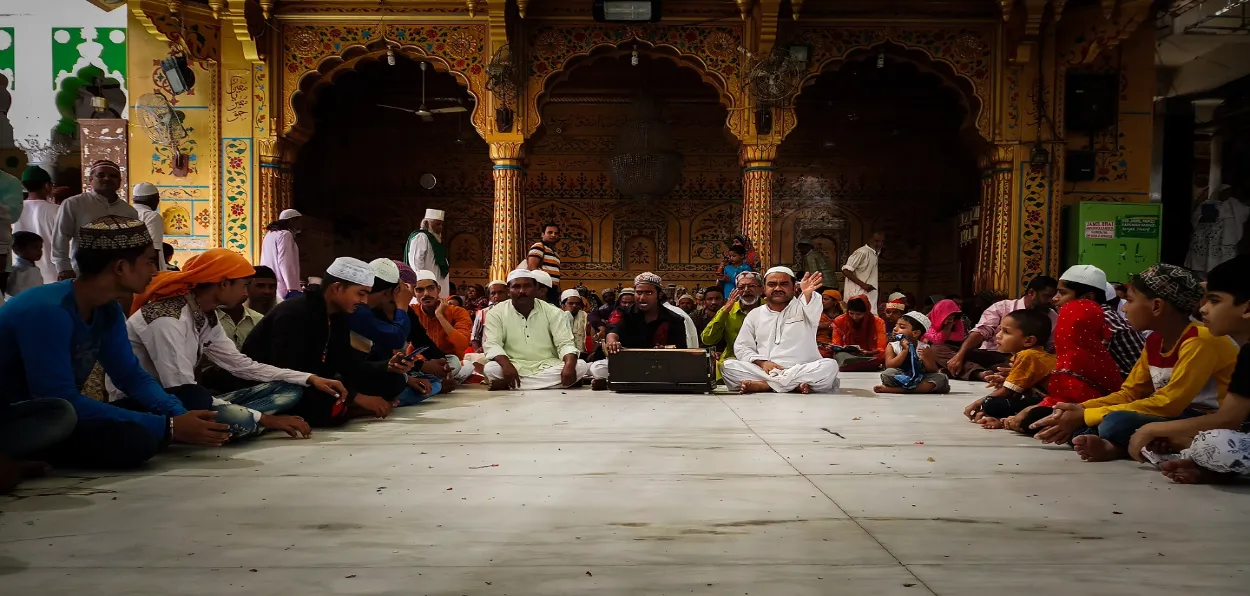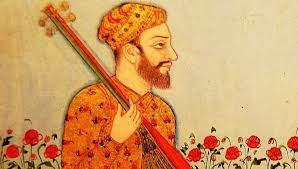
Rita Farhat Mukand
Bengali music had a powerful religious influence and in ancient India, Bengali Muslim music had deep roots in religious influence, traced to 400 years. Indian music in the North East in Assam and Bengal was very rich and varied. Amir Khusrow, the Indo-Persian Sufi singer, musician, poet, and scholar who lived during the period of the Delhi Sultanate praised Bengali music’s richness, depth, and emotional resonance, likening it to the heavenly tunes of angels. He wrote the first Bengali song in praise of Prophet Mohammed, still sung today at Sufi shrines all over Bengal.
Despite music being prohibited according to orthodox Sunni beliefs, sama gained prominence in Sufi khanqas, and Sufi mystical verses began to be composed in ninth-century Baghdad. Renowned figures such as Rabia of Basra, Dhu-ul-Nun of Egypt, and Mansur al-Hallaj of Baghdad emerged as leading exponents of Sufi poetry during this period. However, orthodox scholars like Ibn al-Jawzi and Ibn Taymiya vehemently opposed the practice of sama and any form of music.
The roots of qawwali are intertwined with the history of sama which translates to audition in Arabic. In Sufi tradition, Sama refers to the ecstasies of experiencing spiritual music, an ambiance created to connect with the Almighty through music. A gathering for qawwali is commonly known as 'Mehfil-e-Sama' or 'assembly of listening'. Although qawwali originated in northern India and spread to Bengal, its inception can be traced back to eighth-century Persia, in present-day Iran and Afghanistan.
Traditional Urdu qwwalis typically adhere to specific ragas from North Indian classical music, whereas Bengali qawwali often deviates from the raga system embracing a simple, repetitive melody with minimal improvisation. Thus, despite its connections to North Indian qawwali, Bangla qawwali is seen as an evolving subset of Bengali folk music, still in the process of establishing itself as a distinct musical form. Its popularity is rapidly increasing, particularly in recent years, with practitioners and enthusiasts found across both urban and rural areas of West Bengal. Consequently, Bangla qawwali serves as a significant force in fostering unity among people of diverse religious and cultural backgrounds in the region.
During that early era in Bengal, musical instruments were absent, with only three voices present: one for recitation (Dhrupad), another for singing refrains from Dharmathakur's hymns (Chauta), and the third for performing love songs or folk melodies known as "Bhatiyalasan geet." These compositions were typically straightforward, with lyrics often reflecting the everyday experiences of rural life.
 Amir Khusrow
Amir Khusrow
During the 19th century, Bengali music underwent a massive transformation. Influenced by European music and the interaction with diverse cultures, Bengalis began integrating new musical instruments into their traditions. The Bhatiyals of Sylhet introduced Chaiti geet and incorporated the Saraswati Veena, a chordophone that had been present in European music since medieval times but had not been utilized as an accompaniment for Bengali songs until then.
The term "sitar" originates from the Persian word "sehtar," translating to "three-stringed." Evidence suggests that the instrument evolved from long-necked lutes brought to India from Central Asia. Flourishing particularly in the 16th and 17th centuries, the sitar attained its current form by the 18th century.
This signaled the onset of the modern era of Bengali music, characterized by the importation of instruments from beyond India's borders. Among these additions were the Sitar (1740), Sarod (1820), and even the Tabla (1875). Additionally, the first orchestra setup emerged sometime between 1875 and 1900. Throughout the 20th century, Bengali music continued its evolution, witnessing the introduction of numerous new song forms.
Baul singers of Bengal
The Hindu and Muslim music started to get interwoven in a beautiful unique symphony. Rabindra Sangeet was an enchanting form of music and Rabindranath Tagore has been a powerful influence on Bengal’s music tradition. He used traditional musical forms and experimented with classical ragas to create new songs that have since become popular among Bengali people inside and outside Bengal. It is also known as Tagore Songs or simply Tagore Music which includes the songs written by the poet and those written by others in his honour.
Nazrul Geeti's structure of music was introduced by Kazi Nazrul Islam, who enriched Bangla literature by penning around 1500 songs (many based on folk tunes) during the latter part of the 19th century and early part of the 20th. Nazrulgeeti is a vigorous mixture of traditional folk tunes with some element of modernity. The dhunik Geeti known as the modern Bangla songs, have a history of nearly a hundred years. It is an offshoot of the contemporary cultural movement that produced what was known as new or Adhunik literature, a term that also covered prose and drama.
The term Chalochitro connotes to ‘modern songs.’ Though this music derives its tunes from Tagore’s songs, it is no mere imitation. Chalochitro has its distinctive form; it is closer to Western music than Rabindra Sangeet (Tagore Songs) and Nazrulgeeti (Nazrul Songs). The lyrics are usually written by contemporary poets Imdadul Haq Milon and Shyamal Gupta Busty.
Gaan was started by the Bauls in Bengal known as wandering minstrels and mystic poets who belong to a syncretic religious tradition that combines elements of Hinduism, Buddhism, and Sufism. They are known for their devotional music that explores themes of spiritual love, divine longing, and the search for inner truth. Bauls typically travel from village to village, singing their songs and spreading their teachings, while living a simple and ascetic lifestyle. They play various traditional instruments such as the ektara (one-stringed instrument), dotara (two-stringed instrument), and sometimes the flute. Baul music holds a significant place in the cultural heritage of Bengal, embodying a unique blend of mysticism, philosophy, and folk traditions.
Jama music emerged as a hallmark of the Muslim community, embodying Bangla's response to Hindi film songs and ghazals. Its essence lies in the seamless fusion of Urdu couplets with straightforward Bengali lyrics.
Kazi Nazrul Islam
Bengali Muslims constitute the second-largest Muslim community globally, following the Arabs. Scholars such as Enamul Haq and Richard Maxwell Eaton (1993) highlight the pivotal role of Sufis in this transformation. Haq emphasizes that it was the Sufis, rather than the Muslim rulers, who effectively transmitted the Islamic tradition to indigenous Bengalis, as the rulers struggled to connect with the common people. Eaton's research illustrates how early Sufis not only fulfilled religious and political roles but also played key roles in land cultivation and forest clearance. This all led to the fusion of Islamic Sufi traditions with indigenous Buddhist, Nath, and Hindu cultures, leading to the emergence of syncretic folk-religious movements such as Pir, Baul, and Fakir, as Ahmed Sharif states.
Over time, Bengali music has evolved into different forms due to cultural, social, and technological factors. Post-1990, Bengali youth started producing their genre of music by borrowing influences from modern Western culture taking on musical forms like Blues, Jazz, and popular genres such as modern Bengali pop, rock, hip-hop, electronic dance music (EDM), and fusion music, among others. Bengali rock music has seen a significant change and development. There was a time when Bengalis used to listen to Hindi songs. Because of the influence of Western culture, there was a tectonic shift in the choice of music. Their music is influenced by popular American music and traditional Bengali folk music such as Bhatiali, Bhawaiya, Shyama Sangeet, and Baul.
Some bands play a combination of Shyama sangeet and semi-classical genres. The Jochon band combines Eastern classical ragas with Western orchestrations to create a genre called Bengali opera. Other bands that have experimented with these genres include Souls, Feedback, Warfaze, Miles, etc. The opera style takes its inspiration from the work of the Bishnupur Gharana.
Qawwali mehfil at the shrine of Hazrat Nizamuddin at Delhi
Today, Bengali rock music has created a broad fan base that consists of people from Bengal and people who understand and enjoy this genre of music irrespective of their geographical location. This is primarily because modern-day Bengali rock musicians have tried to change or modify their music by borrowing influences from Bengal as well as the West. These changes have helped them gain more popularity and incorporate traditional folk songs into their albums.
Undoubtedly, modern Bengali music with its input from Hindu and Sufi roots has deeply entrenched itself in the hearts of all authentic Bengalis. What was once derided for its perceived "peculiarity" or "disharmony" has now been seamlessly woven into the very fabric of Bengali existence, becoming an essential aspect of every Bengali's life.
The main reason behind this change is that many different forms and variations were added to make it more appealing to the masses. By applying these changes, musicians managed to create a common ground where traditional folk songs and other forms like Thumri, Khyal, etc., can be blended with this modern form of musical genre. This blended culture has allowed regional populations to adapt to this foreign form of music without compromising their identity.
While critics are upset with this modern evolution deeming that the Bangla culture and originality is getting swamped by this “modern noise”, the creators of modern music argue that all forms of art need constant change and development to survive and connect to the new generations. They are blending the Bengali forms of music into modern-day rock. Marvelously, gifted musicians balance the old and new within their compositions beautifully.
ALSO READ: People in India always support genuine cause: Ruha Shadab
“My only religion is music,” said Rupam Islam, a top figure in contemporary Bengali music rock, lead vocalist and songwriter for the Bengali rock band Fossils, which he co-founded in Kolkata, India, in 1998. Rupam's distinctive vocal style, poignant lyrics, and energetic stage presence have earned him a dedicated fan following. Rupam Islam was born to a Muslim father and a Christian mother does not speak much of his personal beliefs but does express that he sees music as the force to unite humankind more than religion.
Rita Fahat Mukand is an independent writer
